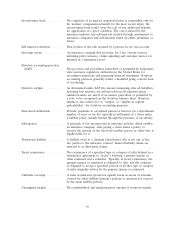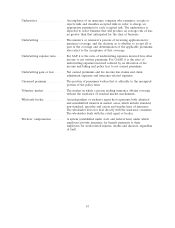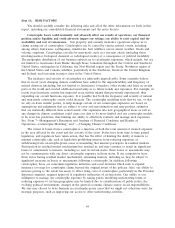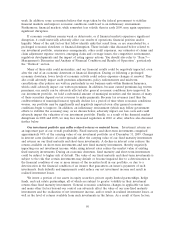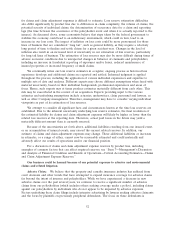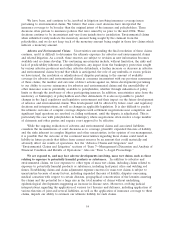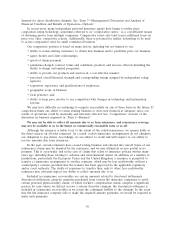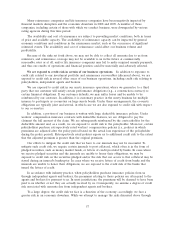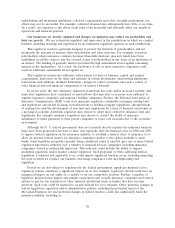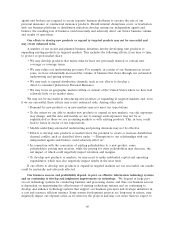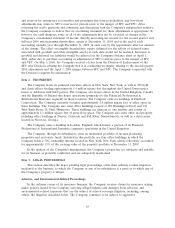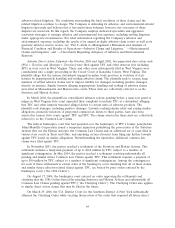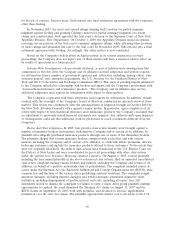Travelers 2009 Annual Report Download - page 68
Download and view the complete annual report
Please find page 68 of the 2009 Travelers annual report below. You can navigate through the pages in the report by either clicking on the pages listed below, or by using the keyword search tool below to find specific information within the annual report.demand for direct distribution channels. See ‘‘Item 7—Management’s Discussion and Analysis of
Financial Condition and Results of Operation—Outlook.’’
In recent years, many independent personal insurance agents have begun to utilize price
comparison rating technology, sometimes referred to as ‘‘comparative raters,’’ as a cost-efficient means
of obtaining quotes from multiple companies. Comparative raters also tend to put additional focus on
price over other competitive criteria. Additionally, there is potential for similar technology to be used
to access comparative rates for small commercial business.
Our competitive position is based on many factors, including but not limited to our:
• ability to retain existing customers, to obtain new business and to profitably price our business;
• agent, broker and client relationships;
• speed of claims payment;
• premiums charged, contract terms and conditions, products and services offered (including the
ability to design customized programs);
• ability to provide our products and services in a cost effective manner;
• perceived overall financial strength and corresponding ratings assigned by independent rating
agencies;
• reputation, experience and qualifications of employees;
• geographic scope of business;
• local presence; and
• ability to keep pace relative to our competitors with changes in technology and information
systems.
We may have difficulty in continuing to compete successfully on any of these bases in the future. If
competition limits our ability to retain existing business or write new business at adequate rates, our
results of operations could be materially and adversely affected. See ‘‘Competition’’ sections of the
discussion on business segments in ‘‘Item 1—Business.’’
We may not be able to collect all amounts due to us from reinsurers, and reinsurance coverage
may not be available to us in the future at commercially reasonable rates or at all.
Although the reinsurer is liable to us to the extent of the ceded reinsurance, we remain liable as
the direct insurer on all risks reinsured. As a result, ceded reinsurance arrangements do not eliminate
our obligation to pay claims. Accordingly, we are subject to credit risk with respect to our ability to
recover amounts due from reinsurers.
In the past, certain reinsurers have ceased writing business and entered into runoff. Some of our
reinsurance claims may be disputed by the reinsurers, and we may ultimately receive partial or no
payment. This is a particular risk in the case of claims that relate to insurance policies written many
years ago, including those relating to asbestos and environmental claims. In addition, in a number of
jurisdictions, particularly the European Union and the United Kingdom, a reinsurer is permitted to
transfer a reinsurance arrangement to another reinsurer, which may be less creditworthy, without a
counterparty’s consent, provided that the transfer has been approved by the applicable regulatory
and/or court authority. The ability of reinsurers to transfer their risks to other, less creditworthy
reinsurers may adversely impact our ability to collect amounts due to us.
Included in reinsurance recoverables are certain amounts related to structured settlements.
Structured settlements comprise annuities purchased from various life insurance companies to settle
certain personal physical injury claims, of which workers’ compensation claims comprise a significant
portion. In cases where we did not receive a release from the claimant, the structured settlement is
included in reinsurance recoverables as we retain the contingent liability to the claimant. In the event
that the life insurance company fails to make the required annuity payments, we would be required to
make such payments.
56


